2.
GHANA
Sawnwood dominates export trade
Ghana¡¯s revenue generated from timber and wood export
for first quarter of 2011 dropped 24% to Euro 30.18
million compared to the same period last year. The
corresponding export volume for the period was
89,680cu.m this year compared to 121,410 cu.m last year.
Air and Kiln dried lumber together accounted for 41% of
the total value of wood exports for the quarter, while the
contribution of plywood exports was 38%, 12 other
products contributed the balance of the total exported
value.
A drop in export volumes of kiln dried lumber (-34.3%),
sliced veneer (-32.2%), air and kiln dried boules (-37.8%)
and parquet flooring (-32.1%) has been attributed to the
inadequate domestic supply of logs.
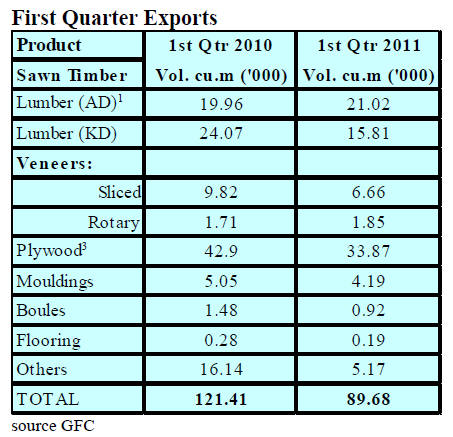
Exports to African countries continue to grow
The ECOWAS market (mainly Nigeria, Senegal, Niger,
Gambia, Mali, Benin, Burkina Faso and Togo) absorbed
86 % of total wood product exports to African countries
and were worth around Euro 13 mil. in the first quarter
2011.
Plywood and air dried lumber (especially of Ofram and
Ceiba) were in high demand and continue to be of interest
to buyers in Nigeria and Niger. Ghana¡¯s exports of wood
products to African countries grew by around 42% in both
value and volume in the first quarter.
Hint of recovery in exports to the US
European markets accounted for 25% of the total value of
exports (Euro 7.56 million) and stood at 19,124 cu.m for
the first quarter of 2011.
Key markets included Italy, France, Germany, the United
Kingdom, Belgium, Spain, Ireland and Holland. The US
accounted for 10% of the value of exports and 4% of the
export volumes, both figures being higher than for the first
quarter 2010.
Markets in Asia such as India, Malaysia, Taiwan P.oC.,
China, Singapore and Thailand together contributed Euro
3.92 million to the total of wood export value in January-
March 2011.
The Middle East countries, notably Saudi Arabia,
Lebanon, United Arab Emirate and Israel together
contributed another Euro 2.55 million.
Ghanaian export mills meeting TIDD price guidelines
Sawnwood prices for traditionally exported species such
as Wawa, Mahogany, Sapele, Makore and Odum
improved slightly during the first three months of 2011.
There were improvements of between Euro 5and Euro 15
per cu.m over the TIDD approved Guiding Selling Prices
(GSP).
With the exception of lesser used species such as Essa,
Yaya, Bompagya, Duabankye and high density species
(especially Ekki, Danta and Denya) which have been
introduced into the Middle East and Chinese markets
recently, exporters were able to achieve the GSP for
sawnwood.
Export prices of plywood continued to increase during the
quarter under review. Prices improved by between Euro 5
and Euro 20 per cu.m. About 70% of the plywood
contracts for the period have been destined for Nigeria.
Prices of Niangon boules to France fell significantly
during the quarter under review. Prices dropped to Euro
450 per cu.m, the GSP price at the tme was Euro475 per
cu.m. However prices of the same product to Germany
were a little better hovering averaging around Euro 460
per cu.m.
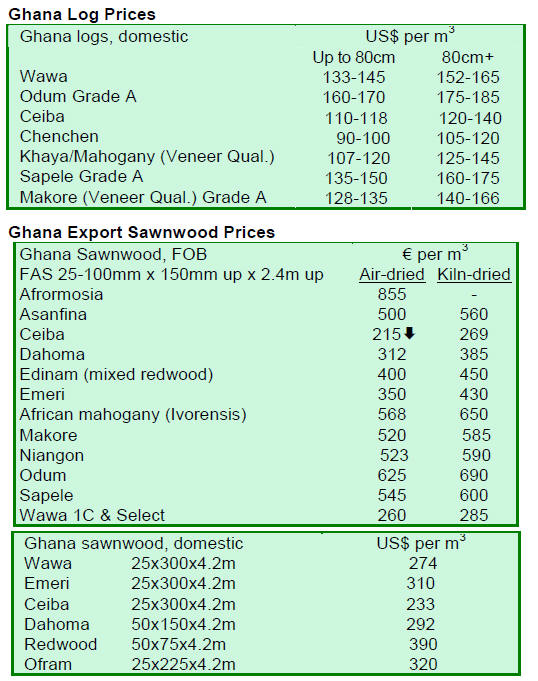
3.
MALAYSIA
Domestic and export price differentials eroded
Prices of Malaysian timber and timber products continue
to rise sharply due to strong demand and higher fuel prices
which are driving up transportation and production costs.
Price differentials between domestic and export quality
wood products are eroding fast.
This is expected to have a spill-over effect on other
building and construction material in the market. The
increase in construction grade plywood prices is expected
to increase construction cost by 10% to 30% for both
commercial and housing projects.
Logging area reduced in 10th Malaysian Plan
The Malaysian National Land Council has set aside
155,000 ha. of forest to be harvested for timber annually
under the Tenth Malaysian Plan (10MP), a reduction of
15,000 ha. from the previous Ninth Malaysia Plan, which
allowed for 170,000 ha. of forest to be harvested annually.
According to the Malaysian Natural Resources and
Environment Ministry, the annual allowable cut was
adjusted to meet criteria set up to determine proper and
effective forestry management.
The ministry added that up to 2008, Sarawak had 6 million
ha. of forest reserve out of 14.43 million ha. for the entire
country.
However, in terms of forested areas, Sarawak had up to
8.23 million ha. this constituted 66.9% of the state land
area, compared to 4.4 million ha. (56.7%) for Sabah and
5.85 million ha. (44.7%) for Peninsular Malaysia.
New ¡®green¡¯ material for industrial applications
The Malaysian Agricultural Research and Development
Institute (MARDI) has succeeded in developing Kenaf
Polymer Composite (KPC) as a ¡®green¡¯ material for
construction and industrial applications. This came as a
result of intensive research and development over a six
year period.
Kenaf is regarded as a suitable substitute for timber
products as it is a short term fibre crop, thus mitigating the
need to harvest timber for wood-based product
applications. The initial market potential for KPC products
is estimated at RM3 billion annually.
Presently, samples of KPC have been sent to the EU for
further testing and certification of its durability and
properties. KPC is regarded as outstanding reinforcing
filler in thermo-plastic composites when combined with
certain plastic resins.
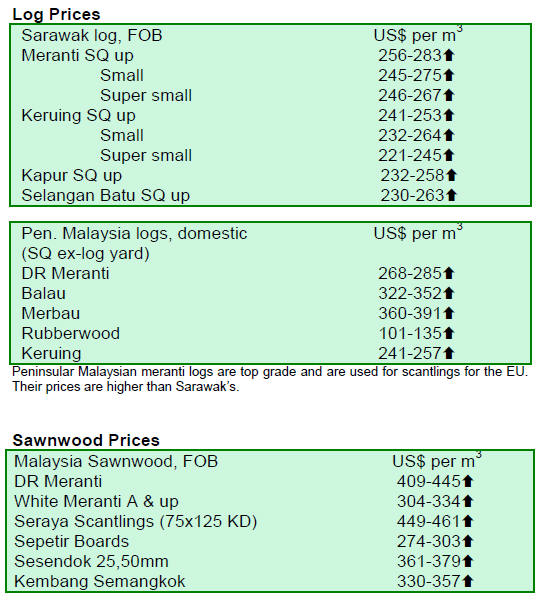
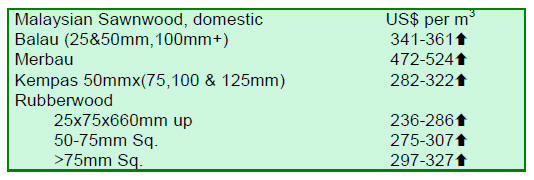
4.
INDONESIA
More transparency on forest
clearing moratorium
The 2 year moratorium on primary forest clearing and
logging provided guidance to the plantation, energy and
construction industries concerning green house gas
emissions, while offering various forms of exemptions and
concessions. The moratorium outlines the following:
• The moratorium mandates ministers and
government officials to suspend the processing of
all permits for logging and forest conversion
purposes, including those for timber and palm oil,
in primary forests and peatlands in the following
government categories: conservation forest,
protected forest and production forest. Permits
however, are allowed for secondary forests,
which have been affected by human and
commercial activities.
• It will be enforced over two years and is open for
extension. Its implementation will be overseen by
a task force on Reducing Emissions from
Deforestation and Forest Degradation (REDD).
• It covers up to 64.2 million ha. of primary forest
and more than 30 million ha. of peatlands. No
compensation will be offered under the
moratorium to firms unable to expand in these
areas, although the government has allocated
another 35 million ha. of "degraded forest" for
commercial development.
The moratorium provides the following
exemptions:
• Firms with existing permits or have approval in
principle from the forestry minister for permits to
log and convert forest.
• Extension of existing permits.
• Projects to develop geothermal and other power
plants, oil and gas fields, sugar and rice
plantations.
• Ecosystem restoration
• The government will regularly update a map of
its forests in a bid to correct overlapping permits
in the sector. The map will be published to help
investors clarify which forest areas are still on
offer and which are not.
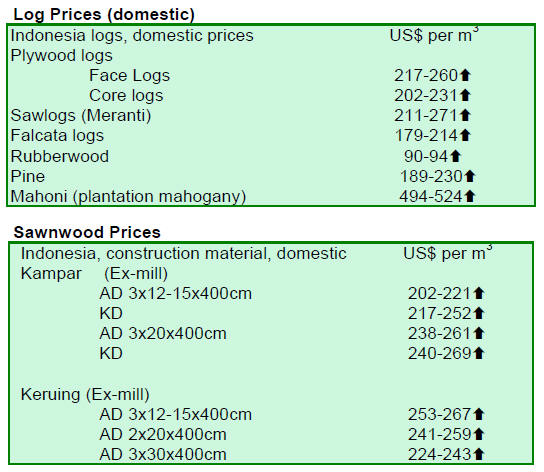
5.
MYANMAR
monsoon strands logs in the forest
Myanmar¡¯s annual monsoon usually begins around the last
week of May or early June but this year the rains started in
April which caught loggers by surprise and they had to
leave a huge quantity of logs in the forest as conditions did
not permit transportation.
The drop in supply of logs triggered an upward swing in
log prices in Yangon and also resulted in some short
shipping.
Importers in Bangladesh steady buyers of Gurjan
Hardwood buyers report that while Gurjan prices are on
the rise the prices of Pyinkado are rather soft as trading is
slow.
The reason for the good Gurjan market is said to be
because of active purchases by buyers for the markets in
China and Bangladesh. Importers in Bangladesh have
always been steady buyers and the logs are used mainly
for sawnwood production.
Will firm April prices be sustained?
The market outlook for teak and other hardwoods has
picked up, one analyst said. It could be seen in the April
hardwood tender sales that export quality Pyinkado
fetched US$ 716 (cf. MTE list price US$ 642 to 678).
Export rejection quality Pyinkado fetched US$ 694 (cf.
MTE list price US$ 578).
Export quality Gurjan (Kanyin) logs fetched US$ 445
(cf.
MTE list price from US$ 375 to 390) Demand for Teak,
especially Sawing Grade 7 (ER1) is very strong but this
quality log is in short supply so demand is expected to
remain high.
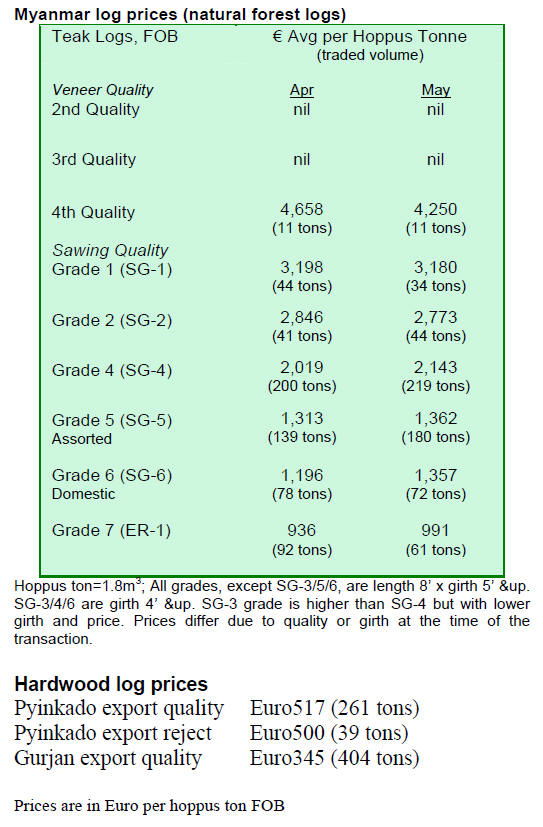
6. INDIA
India sets high export target
As the flow of exports from India improves, the
government of India has set an export target of US$500
billion for 2013-14, almost doubling the US$246 billion
achieved during 2010-11.
The current export policies, diversification of
markets and
technological advances have helped the government
project such an optimistic future. Processed wood product
exporters have also been quite active and expect to
contribute to enhancing the export performance.
Log sales brisk and prices firm
In Western India, the current schedule of log auctions,
which began on the 22nd of May in forest depots in north
and south Gujarat, will continue until the 5th of June.
Thereafter auctions will begin in forest depots of central
Gujarat notably the Vyara, Rajpipala and Tapti regions.
These auctions will run until the third week of
June.
Approximately 6,500 cubic metres of Teak and about
4,200 cubic metres of other hardwoods put up for sales are
of newly harvested logs, sales are expected to be brisk and
prices firm.
Optimism in building sector driving demand
Sales of teak and hardwoods in forest depots of Central
India for example Madhya Pradesh have also seen active
bidding. Reports indicate that approximately 20,000 cubic
metres have been sold and that newly harvested logs,
felled in the current season, continue to arrive.
There is a positive attitude in the Indian building
and
construction sectors and this is driving demand for locally
grown hardwoods as well as Teak. Prices secured in the
central as well as in the western forest depots tend to be
similar as the final market is the same. At present teak
prices per cubic foot Hoppus are as below:
Shipbuilding quality Teak logs Rs.2100~2300
First quality Teak Saw-logs Rs.1700~2000
Long length high girth Teak logs Rs.1500~1800
Average Sawmill quality15ft & up Rs.1000~1200
¡° ¡° 12ft & up Rs.900~1000
¡° ¡° 8ft - 10ft Rs.800~ 900

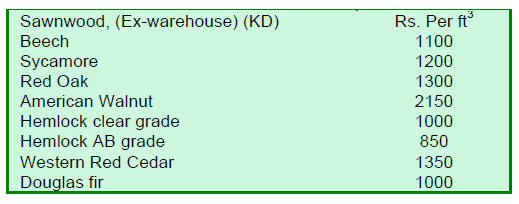
7. BRAZIL
Exports of tropical sawnwood and
plywood fall
In April the value of exports of timber products (except
pulp and paper) declined 5% to US$ 191 million compared
to the level of US$ 201 million in April 2010.
Pine sawnwood exports dropped 2.2% in value in
April
compared to the level in the same month of 2010, from
US$ 13.5 million to US$ 13.2 million. In term of volume,
April 2011 exports were down 9.3% from 62,400 cu.m in
April 2010 to 56,600 cu.m in April this year.
Exports of tropical sawnwood fell both in volume
and in
value, from 46,500 cu.m in April 2010 to 33,700 cu.m in
April 2011 and from US$ 22.7 million to US$ 17 million
in the same period. This corresponds to a 25% decline in
value and a 28% decline in volume.
On the other hand, pine plywood exports increased
7.4%
in value in April 2011 compared to the same month in
2010, from US$29.8 million to US$32 million. The
volume of exports increased 2% from 84,000 cu.m to
85,700 cu.m.
Exports of tropical plywood dropped from 9,600 cu.m
in
April 2010 to 6,500 cu.m in April 2011, representing a
32% fall. In terms of value a 22.2% decrease was
registered.
April was also not a good month for wooden
furniture
exports. Export earnings dropped from US$ 42.4 million
in April 2010 to US$ 40.2 million in April 2011 (-5%).
Furniture exports to Argentina grow
Argentina was the main destination for Brazilian furniture
exports last year. From January to April 2010 exports
totalled US$ 29 million but in the same period this year
exports were up 34% to US$ 40 million.
However, exports to the US and France, the other
two
main importers of Brazilian furniture, have declined so far
this year. Exports to France, the third largest importer of
furniture from Brazil, dropped sharply from US$26
million in January to April 2010 to just US$16 million in
the same period this year, a drop of around 38%.
Overall, Brazilian furniture exports dropped only
marginally from US$ 235 million (January to April 2010)
to US$ 232 million in the same period this year.
Wooden bedroom furniture bucks the trend
According to the Brazilian Association of Furniture
Industries (Abim¨®vel) in the first three months of 2011,
Brazil exported furniture worth US$17.3 million to the
United States. This is some 11.5% lower than that during
the same period in 2010 when exports reached
approximately US$ 19.5 million.
However, Brazilian wooden bedroom furniture is a
favorite in the US market and exports of these items have
been increasing according to the Ministry of Development,
Industry and Foreign Trade (MDIC).
The US/Brazil trade balance in 2010 was in favour
of the
US as the US imported US$ 19 billion but exported US$
27 billion to Brazil. The US is still the key trading partner
for Brazil, not only in the furniture sector but also in the
energy sector.
The trade between the two countries has a long
history and
is of importance and efforts are made so that this shall
remain so in the future.
Economic news
The National Consumer Price Index (IPCA) for April
closed close to the March rate (0.79%). The accumulated
rate for the year to date is 3.23%, 0.58 percent above the
rate of the same period in 2010.
In April the BRL appreciated against the US dollar.
The
Central Bank¡¯s Monetary Policy Committee (Copom)
raised the Selic rate by 0.25 percentage points, to 12% per
year. This move continues the slow down of the rate of
increase in the prime interest rate that began in January
2011, when the rate was raised by just 0.50 percent.
Forest Concession Bidding Process in Para
In Belem, State of Para in the Lower Amazon region more
than 150,000 hectares of public forests were offered for
concession bidding on May 17, 2011. The bidding
committee of the Forestry Development Institute of the
State of Par¨¢ (IDEFLOR) received six proposals for the
available areas.
The forest area put up for bidding is set described
in the
Public Forest Management Law, N¡ã 11.284/2006, and
harvesting in this forest will contribute to the supply of
legal timber. The concession contract requires traceability
of timber production and regular audits and monitoring to
ensure the transparency of legal production.
Moreover, it is hoped that these concessions will
attract
new style of investor since there is a guarantee that
concessionaire can harvest the area in a sustainable
manner and in partnership with communities over a 40
year period. The creation of a Special Bidding Committee
represents a new milestone in forest management in Par¨¢.
"Crisis Cabinet" to combat deforestation
In sharp contrast to the good news given in previous ITTO
market reports, new data shows that the rate of
deforestation in the Amazon has increased again. This data
shows that between August 2010 and April 2011 an area
1,849 sq. km was deforested.
Increases in production of soybeans and corn due to
high
international prices have encouraged producers to clear
more forest also, anticipated changes in the Brazilian
Forest Code are said to be behind the rise in forest
clearance.
The continual delays in the approval of the
Brazilian
Forest Code have had unfortunate consequences. Some
land owners have decided to clear forest land before the
bill on "zero deforestation" is approved in the Brazilian
Congress.
Deforestation in the state of Mato Grosso accounts
for
40% of area registered by the deforestation detection
system. It is reported that the area cleared increased from
505 sq. km to 730 sq.km in a nine month period spanning
2010 and early 2011.
Exceptionally heavy deforestation was detected
March and
April this year. The total deforestation is reported to have
increased from 103 sq.km in 2010 to 593 sq.km in 2011.
The federal government has established a "Crisis
Cabinet"
to expand operations to combat deforestation. The
Environment Minister and the Science and Technology
Minister announced the strengthening of monitoring
through deployment of new satellites by 2014.


8. PERU
Revised Forest Act ready for
congress
The president of the Agricultural Committee of Congress
reported that, in late May, the Land Commission
submitted a replacement text for the Forest Act so it can
now be debated in the Congress.
A number of regional consultations (17) have been
held
and a national meeting consolidated the proposed
amendments. Representatives of indigenous communities
had demanded a review and discussion of 40 items in the
originally proposed act.
The previous law, Decree Law 1090, Law of Forestry
and
Wildlife, was repealed in December 2010 and a new bill
was approved but this was strongly challenged from many
angles by representatives of the indigenous population
which resulted in the review process.
Reforestation target for 2010 achieved
According to reports from AgroRural the executing
unit
within the Ministry of Agriculture, almost 95% of the
reforestation planned for the period 2007-2010 has been
achieved.
The national plan called for the planting of 230
million
trees, up to mid May this year the total planted was 217.8
million. For the 2010-2011 campaign the goal is to plant
60 million trees and so 47.4 million have been planted
(almost 80% of the target).
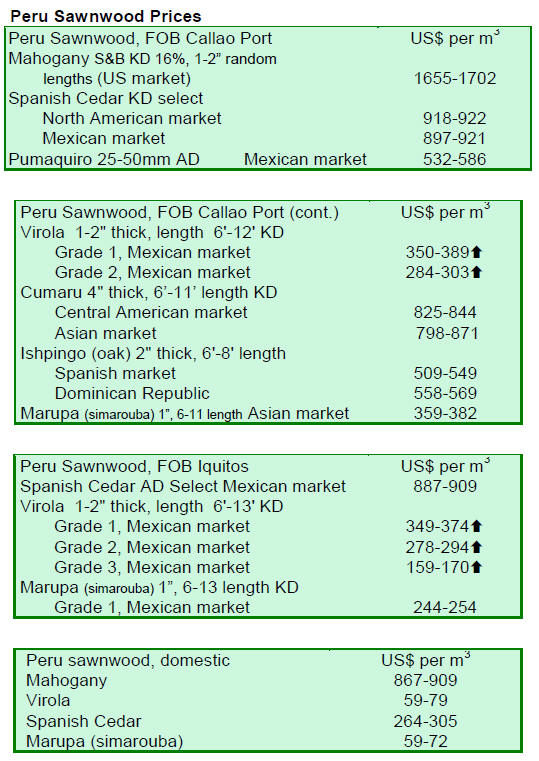
9.
BOLIVIA
Rise in first quarter exports
Exports of timber and non-timber products from Bolivia in
the first quarter increased by 8.7% compared with the
same period last year, rising from US$ 44 million in the
first quarter 2010 to US$48 million in the first quarter of
this year.
Added value goods dominate export trade
The products exported during the year to date are
primarily processed wood products and processed Brazil
nuts.
The wood product exports comprise furniture, doors
and
decking. There is a small trade in primary wood products
such as sawnwood and poles. In the first quarter wood
products accounted for 57% of the total value of exports
the balance being from the export of non-wood products.
Companies in the U.S. continue to be the main
buyers of
Bolivian wood products taking some 26% of exports and
generating US$12.6 million in export earnings for Bolivia.
Buyers in the United Kingdom accounted for a12.6%
share of exports followed by Argentina (8%). The other
significant buyers are in the Netherlands and Germany.

10.
GUYANA
Sawnwood markets resilient
There was no significant export of logs in the period under
review. Even the two main species, Greenheart and
Purpleheart were not exported in any significant
quantities.
However exports of sawnwood made a positive impact
on
the export earnings. Many of Guyana¡¯s species are
exported rough sawn (i.e. undressed) for structural
applications.
These timbers attract good prices and the main
destination
for these durable species is Europe. Dressed sawnwood
continues to be in high demand in the regional Caribbean
market.
Greenheart and Purpleheart prices firming
Prices for undressed Greenheart (select) sawnwood
dropped at the top end of the price range from US$ 806 to
US$ 765, while prices for undressed Greenheart
(merchantable) remained stable. Prices for dressed
Greenheart moved up from US$ 785 to US$ 806 per cu.m.
Undressed Purpleheart (select) sawnwood secured
good
prices, reaching as high as US$ 700 per cu.m. Undressed
Mora prices slipped slightly from US$ 657 to US$ 636.
However dressed Purpleheart recorded saw a decline
in
prices from US$ 1,302 to US$ 890 for this period as
compared to the previous period.
On the other hand Guyana¡¯s Ipe (Washiba) continues
to be
in high demand in North America fetching good prices.
Roundwood and fuelwood also made notable contributions
towards total export earnings.
The export of products such as doors, spindles,
crafts from
Crabwood and Purpleheart and from non timber forest
products all made a positive contribution to export
earnings.
Opportunities sought in Republic of Congo
Guyanese investors and workers may have an opportunity
in the forest products sector in the Republic of Congo.
Currently work is being undertaken to draft a
Memorandum of Understanding (MOU) to be signed
within the next two to three months between the
governments of Guyana and the Republic of Congo.
In Guyana the Forest Products Development and
Marketing Council (FPDMC) is leading the cooperation
agreement.
This is expected to pave the way for Guyana to
access the
Central Africa ¡°Free Zone¡± for wood products and other
goods as well as services.
Currently, there is no trade between Guyana and
Central
Africa. However, if allowed access to the Free Zone
Guyana could enjoy new markets opportunities with 11
different Central African states.
At the same time the two countries are moving ahead
with
a MOU that focuses mainly on cooperation in the area of
forestry. The Guyana¡¯s FPDMC recognises that the
Congo is very advanced in forest management with
recognized certification and log tracking systems.
The MOU will provide for training for mills in the
Congo
on value added wood products and the development of a
business corridor for Guyanese to build houses and
produce wood products in the Congo.
Additionally, the Congo is encouraging Guyanese
businesses to explore joint venture investments with their
counterparts from the Central Africa state. The Congo
Government has also expressed interest in participating in
such ventures.
With Guyana¡¯s help, the Congolese Government is
moving to embark on a major housing drive to construct
wooden buildings for offices and houses.
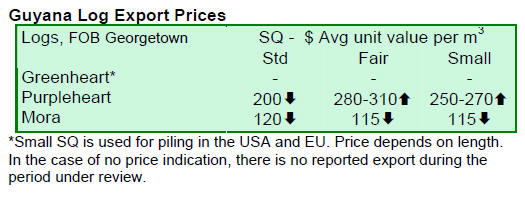
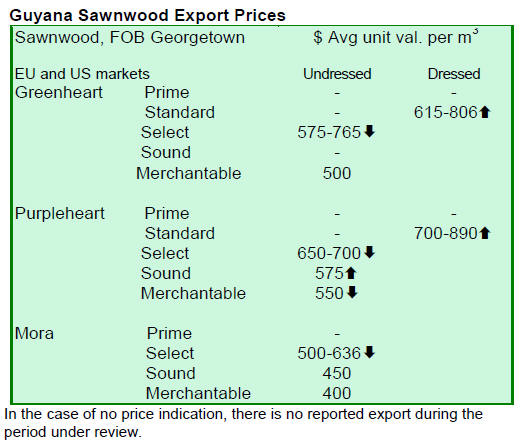
Related News:
¡¡